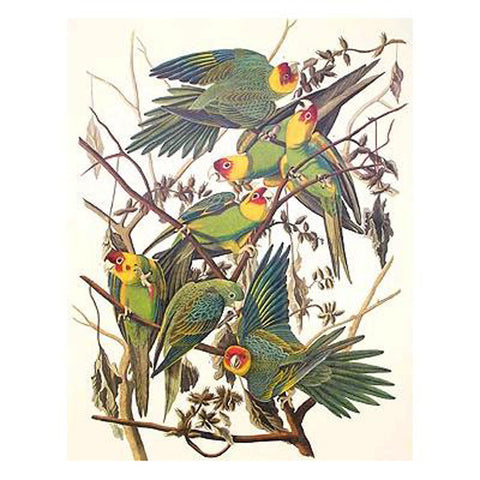Description
Carolina Parakeet, Conuropsis carolinensis
Flora: cocklebur, Xanthium strumarium
Print size: 26 1/4" x 39 1/4"; image size: 23 1/2" x 32"
Princeton Audubon Limited Edition - produced 1985
This print is based on a painting composed in Louisiana about 1825 and inscribed at the lower right: "The upper Specimen was shot near Bayou Sarah and appeared so uncommon having 14 Tail feathers all 7 sizes distinct and firmly affixed in 14 different receptacles that I drew it more to verify one of those astonishing fits of Nature than any thing else-it was a female-The Green headed [a young bird] is also a singular although not so uncommon a Variety as the above one-Louisianna-December-J.J. Audubon."
Audubon wrote of these parakeets, "The woods are the habitation best fitted for them, and there the richness of their plumage, their beautiful mode of flight, and even their screams, afford welcome intimation that our darkest forests and most sequestered swamps are not destitute of charms." In later years he was to write: "Our Parakeets are rapidly diminishing in number, and in some districts, where twenty-five years ago they were plentiful, scarcely any are now to be seen."
This gorgeous bird is now extinct. And little wonder. Its plumage could be sold for millinery, and it was prized as a cage bird both here and abroad. To make matters worse, since it was considered excellent eating and was destructive to a variety of cultivated crops, it was relentlessly destroyed by man.
EHJ
Princeton Audubon prints are direct-camera facsimile lithographs of the Robert Havell Jr. (1793-1878) engravings for The Birds of America (1827-38). Princeton's Double elephant Folio prints are issued in limited editions of 500 or 1500 prints. All are numbered and have a seal in the bottom margin to demonstrate their authenticity.
Printed on heavy Mohawk paper that is recommended by the Library of Congress for archives, the paper is specially toned to match the average paper color of the antique originals.
Item Number:
1707


